 |
||
|
||
| ||
 I have already mentioned some time ago that in order to improve video cards some manufacturers produce not only new types of cards but also new revisions of already released ones. When companies don't have enough opportunities of improving performance of their products (NVIDIA ships video memory chips together with GPUs, and it is quite difficult and costly to look for a faster memory) and when developing of a new design of a card for installation of additional devices (such as VIVO) is very expensive (the majority of GeForce3 cards are thus copies of the reference one) the companies, then, think out new ways of attracting attention of their customers. They resort to, for example, changing of colors of the PCB, supply their cards with daughter ones with VIVO onboard, replace coolers etc. Coolers, by the way, often become a distinguishing feature of many companies. Remember the Leadtek Research company and its massive silvery heatsinks which takes almost 1/3 of the card's surface? Or Gainward with its round cooler with a 3D sticker in the center? Apart from a cooler, there are some other features which can help you say what company has produced a certain card. For example, it is the number of wires coming to a fan: two or three. If there are three the card is probably equipped with a monitoring function, at least it can control a fan speed. And at this moment there are only three companies which provide their cards with the hardware monitoring function: ASUSTeK with its SmartDoctor, Leadtek with its Hardware Monitoring and AOpen with its OpenBIOS. The hardware monitoring technology from Leadtek appeared not so long time ago on one of numerous GeForce2 MX cards. And today we will examine a card which differs from the previous version exactly in this feature. Before we turn to the card in question I should remind you that the whole theoretical base connected with this GPU is concentrated in the following articles (here you can also learn the peculiarities of certain cards and find out how they operate in the latest benchmark tests).
This card has a "TDH" suffix while the previous version WinFast GeForce3 had "TD". I'm sure that "H" stands for Hardware Monitoring. The Leadtek WinFast GeForce3 TD and the today's model go hand in hand in 2D/3D modes, that is why today I will only concern the peculiarities of the card in question and its accessories. CardThe Leadtek WinFast GeForce3 TDH has AGP x2/x4 interface, 64 MBytes DDR SDRAM memory located in 8 chips on the right side of the PCB. 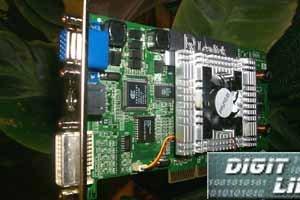 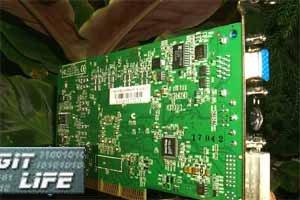 EliteMT produces memory chips with 3.8 ns access time, which corresponds to 260 (520) MHz. Like all other GPU GeForce3 cards, this one works at 200/230 (460) MHz. The memory modules are covered with standard heatsinks that is why it is impossible to look at them. The heatsinks are made of aluminum and have engraved company's logo on their cases. Despite their seeming ineffectiveness the heatsinks cope excellently with their work. And now let's compare the Leadtek WinFast GeForce3 TDH and the reference card NVIDIA GeForce3 (represented by the ELSA Gladiac 920).  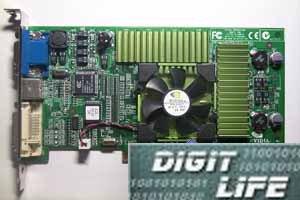 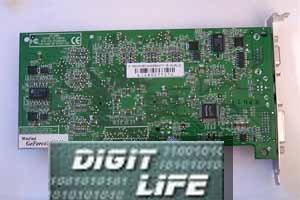 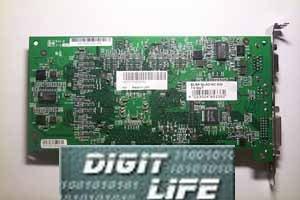 On the photos above the Leadtek WinFast GeForce3 TDH is on the left and the NVIDIA GeForce3 is on the right.  You can see that the Leadtek card slightly differs from the reference one (a part of the PCB of the reference card is shown on the right). First of all, it is a chip in charge of the Hardware Monitoring (on the central heatsink's left). There they had to give up space for a connector of a daughter card with a TV-out (or VIVO).  The photo on the right clearly demonstrates it. One more feature the card differs in is a cooler with a tachometer. And the last distinguishing feature is 3 LEDs located on upper right: 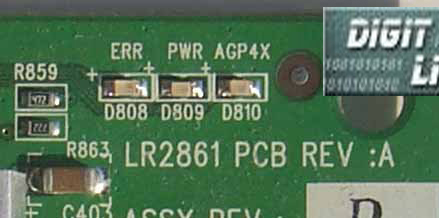 Usually there are two LEDs on: a green one (power supply) and a yellow one (it signals that the AGP 4x mode is activated).  The left LED goes on in case of some bugs or overheating. But during our tests it never went on despite the overheating of the GPU.  The Leadtek WinFast GeForce3 TDH is equipped with a DVI and a TV-out (S-Video connector). The card ships in a Retail package which includes:
This card is almost the first which comes with the latest games which perfectly demonstrate possibilities of the GeForce3. Besides, I'd like to thank Leadtek for the S-Video-to-RCA adapter since lack of such a trifle can cause huge problems to a number of users.  On the photo above you can see a back side of the package. Well, it means that this card has improved 2D quality. According to the graphs, the voltage of the output RGB signal of usual video cards on the GeForce3 is falling down as the resolution increases. The Leadtek WinFast GeForce3 TDH lacks for such problem due to the improved technique of power supply. Well, the test will reveal the truth. OverclockingWith the additional cooling provided, the Leadtek WinFast GeForce3 TDH shows an excellent overclocking potential - it has reached 240/275 (550) MHz. But it isn't new to me; some other cards on this GPU could work even on higher frequencies. Note:
Installation and driversTaking into consideration that it is not a new card but just an improved version I won't test its performance in 3D since it doesn't differ in this respect from other cards and, in particular, from the Leadtek WinFast GeForce3 TD.  Among the programs on the CD there is the proprietary WinFox, a utility which allows you to easily make settings for the card, overclock it, 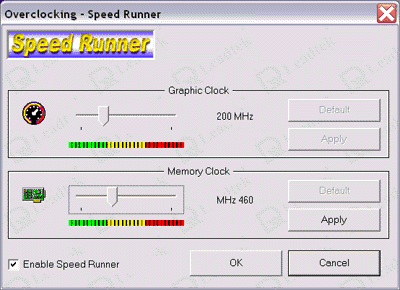 and control its status. 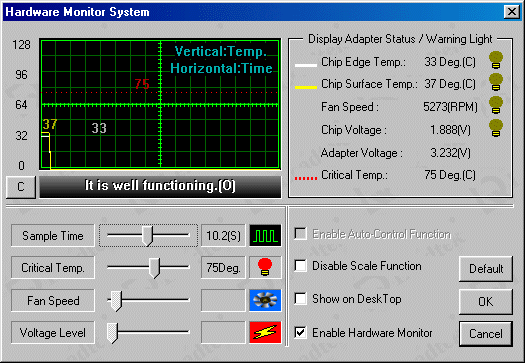 Unfortunately, the Hardware Monitoring works properly only under the Windows 9x/ME, the WinFox doesn't operate under the Windows 2000/XP. I hope this bug will soon be fixed. Test resultsToday this part will be very short. I want attract your attention only to the 2D graphics. Fortunately, almost all Leadtek cards perform quite well in 2D. That is why the earlier released card on the GeForce3 caused no problems up to 1600X1200 at 85 Hz. The differences between the revisions of the WinFast GeForce3 are almost unnoticeable. Only at 2048X1536, when the WinFast GeForce3 TD displayed a rather soapy image, the TDH version couldn't be blamed for the 2D quality. In 1920X1440 at 75 Hz soaping was almost absent; but working on a computer was still impossible, though, because of a too small font. I advise you to read also other reviews of GeForce3 based video cards. Besides, in our 3Digest you can find thorough information on the 3D performance of GeForce3 cards on different platforms. ConclusionThis article extends the review of the Leadtek WinFast GeForce3 TD and points out the differences of the new revision of the Leadtek Winfast card. The Leadtek WinFast GeForce3 TDH offers advanced 2D characteristics, hardware monitoring and ships with a CD with the latest games at almost the same price as its predecessor. The complete characteristics of video cards of this and other classes can be found in our 3Digest. Highs:
Lows:
Write a comment below. No registration needed!
|
Platform · Video · Multimedia · Mobile · Other || About us & Privacy policy · Twitter · Facebook Copyright © Byrds Research & Publishing, Ltd., 1997–2011. All rights reserved. |